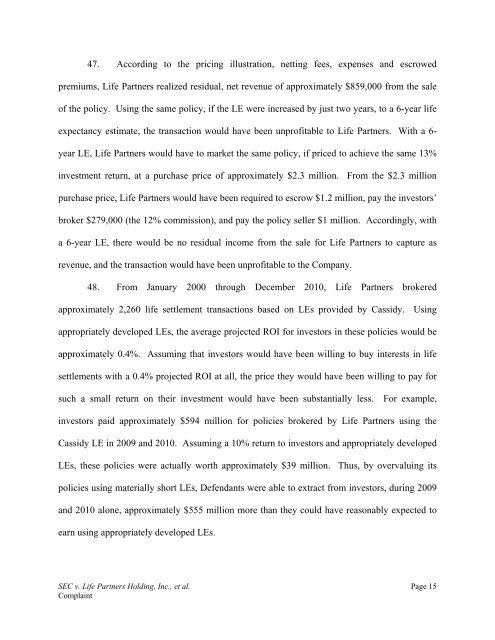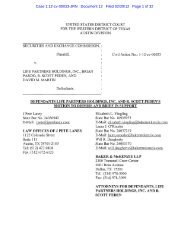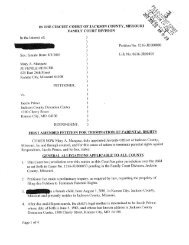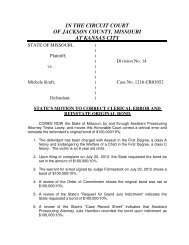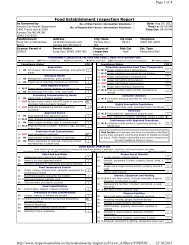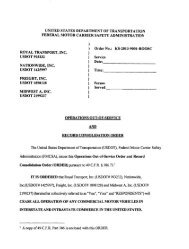Life Partners Holdings, Inc., Brian D. Pardo, R. Scott Peden, and ...
Life Partners Holdings, Inc., Brian D. Pardo, R. Scott Peden, and ...
Life Partners Holdings, Inc., Brian D. Pardo, R. Scott Peden, and ...
You also want an ePaper? Increase the reach of your titles
YUMPU automatically turns print PDFs into web optimized ePapers that Google loves.
47. According to the pricing illustration, netting fees, expenses <strong>and</strong> escrowedpremiums, <strong>Life</strong> <strong>Partners</strong> realized residual, net revenue of approximately $859,000 from the saleof the policy. Using the same policy, if the LE were increased by just two years, to a 6-year lifeexpectancy estimate, the transaction would have been unprofitable to <strong>Life</strong> <strong>Partners</strong>. With a 6-year LE, <strong>Life</strong> <strong>Partners</strong> would have to market the same policy, if priced to achieve the same 13%investment return, at a purchase price of approximately $2.3 million. From the $2.3 millionpurchase price, <strong>Life</strong> <strong>Partners</strong> would have been required to escrow $1.2 million, pay the investors’broker $279,000 (the 12% commission), <strong>and</strong> pay the policy seller $1 million. Accordingly, witha 6-year LE, there would be no residual income from the sale for <strong>Life</strong> <strong>Partners</strong> to capture asrevenue, <strong>and</strong> the transaction would have been unprofitable to the Company.48. From January 2000 through December 2010, <strong>Life</strong> <strong>Partners</strong> brokeredapproximately 2,260 life settlement transactions based on LEs provided by Cassidy. Usingappropriately developed LEs, the average projected ROI for investors in these policies would beapproximately 0.4%. Assuming that investors would have been willing to buy interests in lifesettlements with a 0.4% projected ROI at all, the price they would have been willing to pay forsuch a small return on their investment would have been substantially less. For example,investors paid approximately $594 million for policies brokered by <strong>Life</strong> <strong>Partners</strong> using theCassidy LE in 2009 <strong>and</strong> 2010. Assuming a 10% return to investors <strong>and</strong> appropriately developedLEs, these policies were actually worth approximately $39 million. Thus, by overvaluing itspolicies using materially short LEs, Defendants were able to extract from investors, during 2009<strong>and</strong> 2010 alone, approximately $555 million more than they could have reasonably expected toearn using appropriately developed LEs.SEC v. <strong>Life</strong> <strong>Partners</strong> Holding, <strong>Inc</strong>., et al. Page 15Complaint


